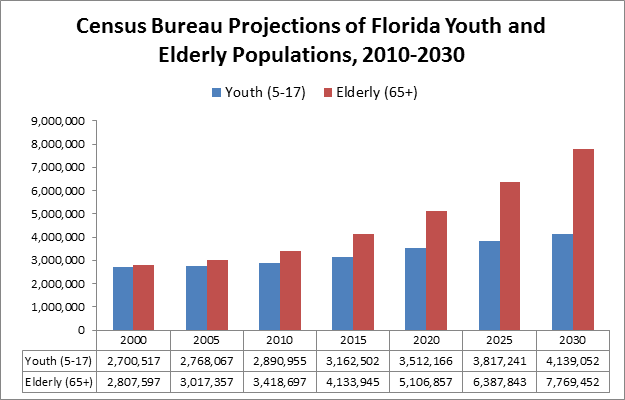 I recently wrote a piece for redefinED about how the Census Bureau projections spell troubled times ahead for Florida. Specifically, the Census Bureau projects a large increase in the youth population to coincide with an explosion in the elderly population. The Cliff Notes version: trouble ahead. Both the young and old consume state services in heavier amounts than average (primarily education and health care respectively) and tend to pay less in the way of taxes on average. The percentage of Florida’s population that will be in the working age population in the years ahead will bear what looks to be a crushing burden in paying for most of this.
I recently wrote a piece for redefinED about how the Census Bureau projections spell troubled times ahead for Florida. Specifically, the Census Bureau projects a large increase in the youth population to coincide with an explosion in the elderly population. The Cliff Notes version: trouble ahead. Both the young and old consume state services in heavier amounts than average (primarily education and health care respectively) and tend to pay less in the way of taxes on average. The percentage of Florida’s population that will be in the working age population in the years ahead will bear what looks to be a crushing burden in paying for most of this.
The Census Bureau has more detailed projections that give more of a blow by blow of how the forecasts this will play out. First, let’s follow the blue columns. This is the Census Bureau projections of the 5-17 population. Note this figure underestimates the potential size of the school age population increase in several ways. First, Florida 4-year-olds can and do use the Voluntary Pre-K (VPK) program. Second, 18-year-olds are often still in high-school. Finally, some children with disabilities remain in public schools until age 21.
With those caveats in mind, note that Florida’s 5-17 year old population goes from around 2.9 million in 2010 to a projected 3.2 million next year, then to 3.5 million in 2020, 3.8 million in 2025 and to a rather alarming 4.1 million in 2030.
So let’s just use rough numbers and say Florida has well over 1.2 million additional students on the way. Fortunately, there are options to deal with this, some or all of which may be used. Florida districts can surround existing school buildings with dozens of portables. At considerable expense, they can build new district schools. They can start running shifts at existing schools.
Perhaps Florida lawmakers will be wise enough to strengthen choice laws to help take the edge off of district enrollment growth. Today a combined 86,000 Florida students attend private schools under the Step Up for Students tax credit and the McKay Scholarship Program for students with disabilities.
The private choice programs represent an especially strong value to taxpayers because they allow students to be educated without the public expense of building new buildings. These costs prove quite considerable. Island Coast High School in Cape Coral, which opened in 2008, cost $63,000,000 to provide learning space for 2,000 students. Florida has far more than 1.2 million students projected to be on the way in the next decade and a half. A project like Island Coast High School can accommodate .0017 percent of that cohort.
I am confident a great many construction firms and bond brokers would love to either pave Florida over with new district schools or die trying. The red columns, however, show rather conclusively that is not a really an option. Florida’s elderly population is set to more than double between 2010 and 2030. This will translate into a greater demand for a variety of public services, strains on pension funds, and less in the way of tax revenue.
Absent some implausible spike in economic growth, these projections foretell fierce competition for limited public dollars between old and young. Note the elderly tend to be better organized and vote in much greater numbers than public school interests. Place your bets accordingly.
Yogi Berra sagely noted predictions are hard, especially when they are about the future. Nevertheless, I’ll brave a few that seem painfully obvious. First, Florida’s public universities should be planning to live without taxpayer assistance. When state budget crunches hit, state lawmakers can’t increase tuition for state prisoners. They also find it bad for societal satisfaction to set them loose for lack of funds. Hyper-inflation in health-care costs narrows options considerably.
Second, the current hostility towards parental choice in Florida will increasingly be understood by sober-minded people as antiquated. Florida public schools enjoy a constitutionally protected status and broad public support, but even the best schools have students who would be better served somewhere else or by some other method of education. There is absolutely no way Florida will sail through the approaching storm without an improved public school system. It is also the case, however, that there is no chance the system can manage this on its own.
Florida’s methods for providing K-12 education must become more effective and more cost-effective. This is not a task for tomorrow. The generation that will be expected to pay the taxes to keep the retirement and health care programs and K-12 system going are in the Florida school system now. Despite strong improvement in outcomes since the late 1990s, only a minority of Florida students display full grade level proficiency in math and reading.
If I were retiring in Florida, I think I’d like to have a large majority of working-age people fully literate and able to work out an algebra problem in a pinch, among other things. Some of you may feel differently, but I suspect most of you do not.
Finally, I predict there will be calls for Florida to institute a personal income tax and raise other taxes in an effort to preserve the status quo. Given the scale of the challenge, the experience of Detroit seems instructive. A manufacturing juggernaut, Detroit had the highest per-capita income in the world in the early 1950s. The introduction of the interstate highway system led to new municipal jurisdictions and greater tax competition between them. People could work in Detroit but live in Ann Arbor. People and their tax revenue began to bleed out of Detroit.
Detroit’s leaders made the catastrophic mistake of introducing a city income tax in 1961. This of course was an optional city income tax, as you merely needed to move past 8-Mile Road to avoid paying it. There is much more to this sad story, of course, but in many ways it was all downhill after 1961. Today, the population of Detroit is about a third of its peak, the city is bankrupt, there is talk of bulldozing entire neighborhoods and as many as 50,000 wild dogs roam the streets.
Note the interstate highway system also exists in Florida – and that a great many states will have smaller demographic challenges than Florida. I-10, for instance, leads straight to Texas. Texas will be happy to steal Florida’s school lunch money by soaking up economic development. Florida in short cannot successfully tax its way out of the grey tsunami/baby boom combination. Any serious attempt to do so will inflict massive economic harm while ultimately failing.
Florida’s crucial edge lies in innovation. Florida has not only tried new approaches to public policy, it has enjoyed promising successes with them. For instance, it leads the nation in digital learning and has the largest private choice programs.
Despite adding 90,000 new public school students a year, Texas still has a cap on charter schools and seems intent on attempting to pave the state over in $85 million new high-schools surrounded by portables. Advantage, Florida. But the scale of your ambition must grow to match the size of your challenges. The Step Up For Students tax credit, for instance, improves learning for public and private school students while saving the state money, so, well…
In facing unprecedented demographic change, Florida is about to sail off the map, right past the part that says “Here there be Monsters.” The entire social welfare state, including K-12 education, must be reformatted to deliver more effective and more cost-effective services. In K-12 this will require expanding choice to education methods rather than simply schools, and creating incentives for bottom-up economizing.
This is a task for Hercules, but Florida has already established a reputation as a national leader. It would be much better for the rest of the nation to learn from your continued success than from a series of catastrophic failures.





Dr. Ladner: The educational challenge is even greater than you say. Our economy demands that we dramatically improve student learning in math and science. It is more expensive to teach these subjects well than it is to teach history well – both at the K-12 and postsecondary levels. We have agonizing choices ahead of us.
Matt—This is a great piece of writing…thank-you. We’re going to try and make sure this gets circulated in Florida.
Doug
Matt: Great piece. The increase in raw numbers of very young and very old should send a warning to state policymakers. I was wondering if these groups are also growing as a percentage of the population. If the 18 to 64 population was growing at a similar rate then the problem might not be as severe. Sorry if it’s already in your post, I may have missed it.
Chad
Doug-thank you.
Paul- I agree, and it will be incumbent upon us to develop better and more cost-effective methods for imparting this set of knowledge and skills. I don’t have all the answers on this, but agree on the problem.
Chad-the 18-64 cohort is set to shrink as a percentage of the population in all states between now and 2030, and Florida is going to have it worse than most. The key thing for Florida to be concerned about if they make the mistake of trying to tax their way out of this would be to lose their successfully employed working age population to states with faster economic growth and smaller demographic burdens (e.g. Texas).
Those praising Mr. Ladner are advised to see the awards he got from NEPC due to shoddy work. Beware what you fall for.